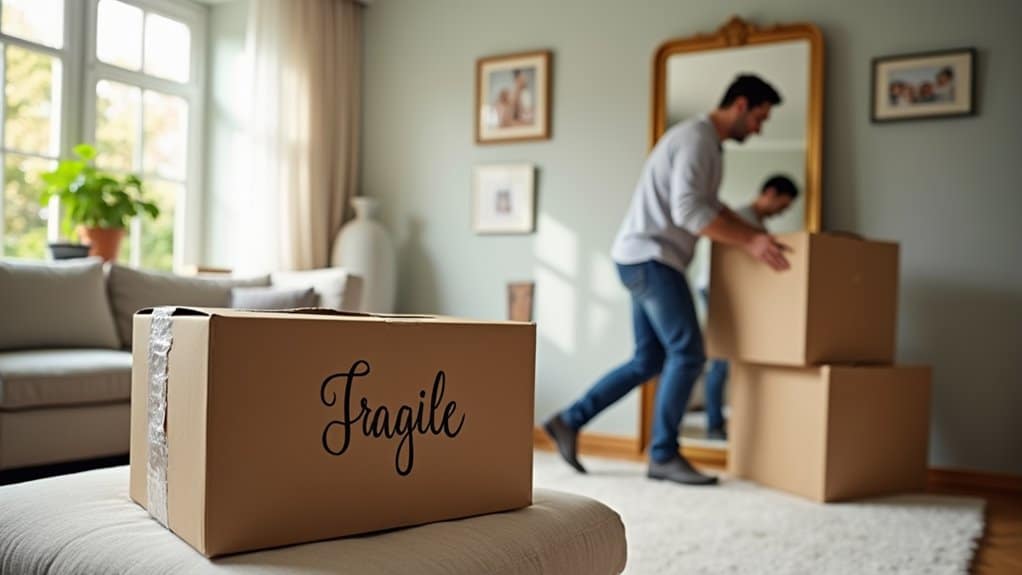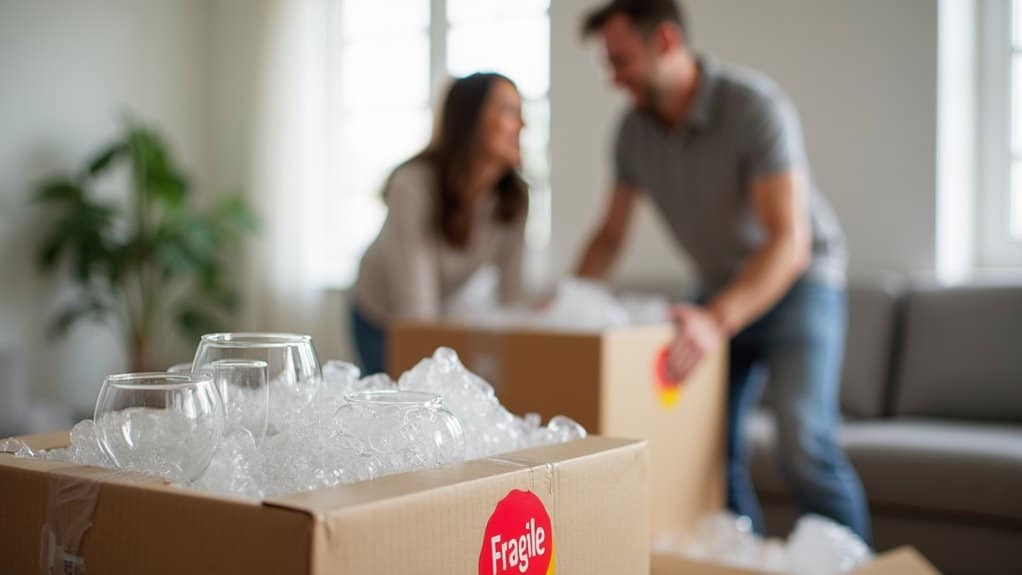
The Importance of Removal Insurance for Domestic Moves
Removal insurance is crucial for your domestic move as it protects your belongings from loss or damage during transit. Unlike standard home insurance, removal insurance specifically covers risks such as theft and breakage that can occur while loading or unloading. This type of coverage offers financial security and peace of mind, ensuring you won't be left to foot the bill for damaged or lost items unexpectedly.
For instance, if a prized piece of furniture gets scratched or a box of valuables goes missing, having removal insurance means you can claim for these losses rather than bearing the cost yourself. Additionally, opting for higher-quality insurance often correlates with better service from your moving company.
In short, understanding your removal insurance options can help you avoid costly mishaps during your move. It's an important aspect to consider as you plan your relocation.
Key Takeaways
- Removal insurance is crucial for protecting your belongings during a move, covering risks that standard home insurance typically doesn't.
- It helps cover unexpected costs if items are lost or damaged, reducing financial stress during what can already be a costly time.
- Most home insurance policies don't provide coverage for damage or loss while moving, so having removal insurance is essential for complete peace of mind.
- Understanding the claims process can make it easier to resolve any issues quickly, ensuring a smoother moving experience.
- You can often customise removal insurance policies to suit your specific needs, giving extra coverage for valuable items and helping to ease the anxiety that comes with moving.
Understanding Removal Insurance
When preparing to move, understanding removal insurance is crucial for protecting your belongings. Removal insurance consists of specialised policies that cover risks not included in standard home insurance, such as damage during transit, loading, and unloading. It's important to note that insurance not mandatory for moving but is highly recommended to safeguard your possessions.
There are different types of policies available, including full-value protection, which provides comprehensive coverage for repair or replacement, and released value protection, which typically offers limited coverage. It's vital to know what's covered. Most policies protect against external damages like theft, fire, and accidents, but be cautious of specific exclusions, particularly for fragile or high-value items. Additionally, reputable removalist companies typically have their own insurance policies that may provide added coverage during the move.
To make informed choices, compare policies based on coverage limits, exclusions, and your specific moving needs. On average, removal insurance costs about 10% of your total moving expenses. If you own high-value items, expect higher premiums.
Financial Security Benefits
When you opt for removal insurance, you gain vital coverage for any lost items, meaning you won't have to shoulder the full financial impact of unexpected losses. This protection not only secures your belongings but also protects you from surprise costs that can arise during a move. By investing in insurance, you're effectively managing risks and ensuring peace of mind throughout the process. For instance, if a valuable piece of furniture goes missing, removal insurance can help cover its replacement cost, saving you from a hefty out-of-pocket expense. Additionally, this insurance covers loss and damage during moving due to external forces, providing an essential safety net during your relocation. Moreover, professional movers often offer valuation insurance options that enhance your coverage during the moving process.
Coverage for Lost Items
In the often chaotic process of moving, having coverage for lost items is vital for peace of mind. Standard home insurance typically doesn't cover losses during a move, unless specific events like theft or fire occur. That's where lost item coverage comes into play.
By choosing removals insurance, you protect yourself financially against unexpected losses or damage while your belongings are in transit. Many reputable removal companies offer insurance options that can be tailored to your specific needs.
You can enhance your existing policy with scheduled personal property coverage, which safeguards valuable items such as antiques, electronics, or artwork that may not be included in standard policies. Additionally, it's important to note that policies may include replacement cost or actual cash value for lost items, ensuring you're adequately compensated.
Removals insurance generally covers losses due to external factors, including collisions, theft, and flooding, and it also provides liability protection for any injuries that may occur during the moving process.
This insurance not only eases your concerns about safeguarding your possessions, but it also covers replacement costs if items go missing.
You can customise your policy to meet your needs, ensuring you're prepared for any eventuality.
Investing in lost item coverage allows you to concentrate on your move, secure in the knowledge that your treasured belongings are protected.
Protection Against Unexpected Costs
Moving can often come with unexpected challenges, and having protection against unforeseen costs can provide essential peace of mind. Without removal insurance, you may find yourself facing unexpected repairs or losses that can upset your budget. This financial safety net allows you to handle unexpected expenses without draining your savings, helping you adhere to your budgeting plans. Moreover, income replacement insurance can help ensure that you remain financially stable during life changes, such as moving.
Here's a brief overview of the types of financial protections available:
| Type of Protection | Description |
|---|---|
| Full Value Protection | Covers the full value of damaged items. |
| Released Value Protection | Limited coverage, usually at no extra cost. |
| Third-Party Insurance | Covers high-value items and additional risks. |
| Liability Protection | Covers injuries that occur during the move. |
| Packing & Storage Coverage | Protects costs linked to packing and storage. |
Ensuring you have the right protection can make your move smoother and less stressful.
Types of Protection Offered

Choosing the right type of protection for your belongings during a move is crucial for peace of mind. There are three main types of coverage you should consider: Basic Liability Coverage, Full Value Protection, and Third-Party Moving Insurance.
Basic Liability Coverage, or Released Value Protection, is usually provided at no extra cost. However, it offers limited protection at around £0.60 per pound per item, which may not suffice for valuable items like electronics or antiques.
Full Value Protection offers more comprehensive coverage, covering repair, replacement, or cash reimbursement for damaged items. Be sure to check the liability limits, as certain high-value items may have exclusions. This type of insurance is essential for safeguarding belongings during a relocation process.
If you possess expensive belongings, Third-Party Moving Insurance is worth considering. This option allows you to tailor coverage to your needs and often includes the full value of your items, offering added reassurance.
Don't forget to look into goods in transit insurance and removals insurance for broader protection against theft, fire, and natural disasters.
It's also wise to check your existing home insurance policy, as it may not cover removals. Making an informed choice now can help you avoid unexpected losses later.
Importance of Coverage During Moves
Understanding the risks involved in moving underscores the need for proper coverage for your possessions. Many people mistakenly believe their items are automatically insured during the move. However, unforeseen events—such as severe weather or delays—can lead to loss or damage.
Even with careful planning, accidents can happen due to factors outside the moving company's control. Investing in removal insurance provides financial protection and peace of mind. If your belongings are damaged or lost, insurance can help cover the costs, reducing stress during an already busy time.
Familiarising yourself with moving logistics can assist you in selecting the right coverage, ensuring protection against unexpected expenses like theft or collisions. It's crucial to evaluate coverage options, as some moving companies may only provide minimal protection.
Choosing comprehensive insurance can shield your belongings from various risks and ensure a higher standard of service. Ultimately, securing adequate coverage not only protects your valuables but also improves your overall moving experience.
Don't let misconceptions about insurance jeopardise your belongings—invest in the coverage you need for a smoother, worry-free move.
Homeowners Insurance Limitations

When moving house, it's important to be aware of the limitations of your home insurance, as it often doesn't cover damage to your possessions during the move.
Common exclusions include breakages due to mishandling or inadequate packing, which can leave you exposed.
To safeguard your belongings, carefully review your policy and consider additional coverage to address any potential gaps.
Coverage Gaps Identified
Many homeowners are unaware of the significant limitations that often come with standard home insurance policies, particularly when it comes to moving. A coverage assessment shows that typical policies only protect your belongings against specific risks like fire and theft. Unfortunately, this coverage often diminishes when items are in transit, leaving you exposed to potential loss or damage.
| Limitations | Impact on Coverage |
|---|---|
| Named-peril basis | Limited protection during moves |
| Lower limits during transit | May not cover the full value of items |
| Breakage not caused by perils | No coverage for accidental damage |
It's crucial to evaluate your current policy. Standard home insurance might not adequately cover high-value items such as jewellery or collectibles. This gap can result in considerable financial loss if your possessions are damaged while moving. To ensure all your items are protected, consider additional coverage options from moving companies or modify your current policy. Understanding these coverage gaps will help you safeguard your belongings during a move.
Exclusions During Moves
Moving your belongings can be both exciting and daunting, but it's crucial to understand the limitations of your home insurance during this time.
While your policy may provide some coverage, it often comes with significant exclusions that could leave you exposed to moving risks.
Here are some key exclusions to be aware of:
- Damage during transit: Most home insurance policies won't cover damage to items while they're being moved.
- Storage limitations: Coverage may only apply to catastrophic losses in storage, not for individual items.
- Breakage: Accidental breakage, such as dropping items, is typically not covered.
- Moving van accidents: While there may be coverage for total loss in an accident, minor damages often aren't included.
- Policy specifics: Each policy is different, so it's essential to review yours to see what's covered.
Given these exclusions, relying solely on your home insurance can be risky.
Consider looking into separate moving insurance or additional coverage options to ensure your belongings are fully protected during your move.
This can help provide peace of mind and safeguard against unexpected costs.
Policy Review Recommendations
Understanding the limitations of your home insurance is crucial, especially when preparing for a move. Most home insurance policies don't cover damage to your belongings during the moving process unless this is specifically mentioned.
It's vital to read your policy thoroughly to identify any exclusions that could expose you to risk. Be aware that many policies typically cover only major damage, not everyday accidents like dropping items.
If your possessions will be in storage, check whether your policy includes coverage, as this often comes with specific conditions. Consulting your insurance agent can help clarify any questions about coverage during the move.
They can explain how your current policy deals with items in transit, particularly since standard policies often operate on a named perils basis. If you're using a professional mover, keep in mind that moving companies must offer liability options for long-distance moves.
Lastly, remember to inform your insurer about your upcoming move to ensure your coverage is appropriate for the risks associated with your new home. Taking these steps can help protect your belongings throughout the moving process.
Key Policy Considerations
When moving home, protecting your belongings should be your top priority. Being aware of key policy considerations can help you avoid misunderstandings that could leave you vulnerable during this important time.
Here are some essential points to consider:
- Check your home insurance: Verify whether your current policy covers items while they're in transit.
- Be aware of limitations: Homeowners' insurance may provide only limited protection for possessions during a move.
- Speak to your insurance agent: Discuss any necessary changes to your policy and confirm any new requirements.
- Consider additional insurance: You might want to look into removals insurance for enhanced protection during your move.
- Understand deductibles: Keep in mind that any deductibles will impact your claims process.
Types of Coverage Explained

Choosing the right type of coverage for your move is crucial for protecting your belongings. There are three main options: Full Value Protection Insurance, Released Value Protection, and Third-Party Moving Insurance. Each has its advantages and disadvantages, so it's important to understand how they compare.
Full Value Protection offers comprehensive coverage, ensuring that your items are repaired or replaced based on their full value. This is especially beneficial for high-value or sentimental items, although it may come at a higher cost.
In contrast, Released Value Protection is often included at no extra charge but provides minimal reimbursement based solely on the weight of the items, which could leave you significantly out of pocket if anything valuable is damaged.
Third-Party Moving Insurance allows for customised coverage to meet your specific needs. While it offers extensive protection, it typically incurs additional costs and requires separate paperwork.
Many people mistakenly believe that their homeowners or renters insurance covers items during transit. In reality, it's vital to carefully assess your options and select the coverage that best protects your possessions throughout the moving process.
Impact on Moving Stress
When you're moving, the last thing you want is to worry about unexpected losses or damage to your belongings.
Removal insurance offers financial peace of mind, ensuring your items are protected against unforeseen events. This coverage not only safeguards your possessions but also allows you to concentrate on settling into your new home without the added stress of potential financial burdens.
For example, if a valuable item gets damaged during the move, having insurance means you won't face a hefty expense to replace it.
Financial Peace of Mind
Navigating the challenges of a domestic move can be daunting, but having removal insurance can significantly ease financial worries.
This insurance is essential for effective financial planning during your relocation, allowing you to focus on settling into your new home.
Investing in removal insurance comes with several benefits:
- Financial Security: You'll be compensated for any damaged or lost belongings.
- Savings Protection: You won't have to use your savings for replacements.
- Reduced Burden: It lessens the financial pressure during the move.
- Focus on Adjustment: You can concentrate on adapting to your new surroundings.
- Peace of Mind: You'll feel more secure throughout the moving process.
In essence, removal insurance is a smart choice for anyone looking to make their move smoother and less stressful.
Protection Against Unexpected Losses
While achieving financial peace of mind during a move is crucial, safeguarding against unexpected losses is just as vital. Removal insurance provides comprehensive coverage for your belongings, protecting against accidents, theft, and natural disasters.
With options like full-value and released-value protection, you can select the level of coverage that suits your needs. Full-value protection ensures that valuable or sentimental items are repaired, replaced, or reimbursed if damaged.
Before your move, it's wise to conduct a risk assessment to identify potential vulnerabilities. Items may be at risk of accidental breakage during packing, issues during transit, or damage from external factors like fire or collisions. Knowing your belongings are insured helps ease the stress of potential financial loss.
Additionally, choosing a fully insured removals company enhances your moving experience. Their expertise, coupled with solid insurance, allows you to focus on settling into your new home rather than worrying about possible mishaps.
Peace of Mind for Movers

Moving day can be hectic, with boxes piled high and emotions running high. However, knowing your belongings are protected can significantly ease the stress. Investing in removal insurance helps mitigate moving anxiety and improves your overall preparation.
This peace of mind allows you to concentrate on the excitement of your new home rather than worrying about potential mishaps.
Here are some key benefits of having moving insurance:
- Protection against unexpected damage during the move.
- Financial support for repairs or replacements of lost or damaged items.
- Coverage for accidental breakage or theft, which helps reduce stress.
- Streamlined claims process, making it easier to resolve disputes.
- Comprehensive coverage for incidents caused by external factors like fire or flooding.
With moving insurance, you ensure that unforeseen costs won't disrupt your plans. It's a smart way to protect your belongings and maintain peace of mind throughout the moving process.
Flexibility in Coverage Options
When it comes to removal insurance, having flexible coverage options is crucial for safeguarding your belongings.
You can select tailored coverage that meets your specific needs, ensuring you don't pay for unnecessary extras.
With customised policy choices and various protection levels, you can secure the right amount of coverage for both valuable items and everyday possessions, like your electronics or furniture.
This way, you can have peace of mind knowing your belongings are protected without overspending.
Tailored Coverage Solutions
Tailored coverage solutions provide the flexibility needed to safeguard your belongings during a move. With various specialised options available, you can customise your insurance to meet the specific needs of your items, avoiding generic policies that may not cover what matters most to you.
Here are some key coverage options to consider:
- Full Value Protection: Comprehensive coverage for high-value items such as antiques or electronics.
- Released Value Protection: Basic coverage at no extra cost, but it offers minimal protection.
- Packing Coverage: Additional protection for items that might be improperly packed, like fragile glassware.
- Storage Insurance: Coverage for goods stored during the transition, useful if there's a delay in moving into your new home.
- Third-Party Insurance: Extra protection beyond what your moving company provides, ideal for added peace of mind.
Choosing the right option depends on factors like the value and type of items you're moving. By understanding your choices, you can ensure your belongings are well-protected, whether through custom policies or specialised coverage.
This tailored approach gives you reassurance that your items are secure throughout your move.
Customized Policy Options
Choosing the right insurance for your move involves more than just selecting a plan; it's about finding coverage that meets your specific needs. With customised policies, you can tailor your insurance for both local and long-distance moves, ensuring you have the protection you require.
For long-distance moves, you'll come across mandatory coverage options like Released Value Protection (RVP) and Full Value Protection (FVP). RVP is offered at no cost but provides limited coverage. In contrast, FVP must be purchased, offering compensation based on the current market replacement value of your belongings.
When planning a local move, coverage requirements are governed by state regulations, and many reputable movers offer customised insurance options. This flexibility allows you to create insurance that caters to the value of your specific items.
Whether you have high-value possessions or need coverage for temporary storage, understanding your options is crucial. By keeping a detailed inventory and evaluating the worth of your belongings, you'll be well-equipped to select the right customised policies for peace of mind during your move.
Diverse Protection Levels
When moving, it's essential to choose the right level of protection for your belongings, tailored to your needs and budget.
Here's a straightforward overview of the main coverage options available:
- Full Value Protection: This offers comprehensive coverage for the replacement value of your lost or damaged items, providing peace of mind during your move.
- Released Value Protection: A basic, government-mandated option that offers limited compensation at £0.60 per kilogram per item, making it suitable for lower-value possessions.
- Third-Party Insurance: This optional insurance provides extra protection beyond the basic carrier liability, especially beneficial for high-value or fragile items.
- Coverage Comparison: It's wise to compare policies from different providers to ensure you select the best coverage for your specific situation.
- Inventory and Documentation: Keeping a detailed inventory and photographs of your belongings can significantly aid the claims process in case of any issues.
When considering these coverage options, think about the value of your items and your financial situation.
A careful choice can help you avoid losses and ensure a smooth moving experience.
Don't risk leaving your belongings unprotected; explore your options today!
Simplifying Claims Processes

A streamlined claims process can significantly improve your experience with removal insurance for domestic moves. Thanks to advancements in claims technology, filing a claim has become straightforward. You can use easy-to-navigate online platforms or mobile apps to submit your claims, minimising the risk of errors.
Digital documentation enables you to take photos of any damage and attach them directly to your claims, removing the need for cumbersome paperwork. Automated workflows guide you through each step, ensuring you don't miss any crucial information, enhancing both accuracy and speed.
Real-time updates keep you informed about your claim's progress, increasing transparency and reducing any stress. With AI and automation assessing claims promptly, you'll find that processing times and errors are significantly reduced.
Documenting Your Move
Documenting your move is vital for protecting your belongings, alongside simplifying the claims process for removal insurance. Start by creating a detailed inventory list of all items, including furniture and electronics.
Take clear, dated photographs from multiple angles to show their condition, and include descriptions with brand and model information to support any claims you may need to make later.
Here are the key steps for documenting your move:
- Create an inventory list of all items.
- Take photographs of each item from different angles.
- Keep receipts and purchase details for proof of value.
- Note the condition of items before the move.
- Maintain a moving log to track important events.
Choosing Insured Removal Companies

Choosing an insured removal company is vital for protecting your belongings during a move. First, ensure the company has valid insurance and check the details of their coverage. Ask for a copy of their insurance policy to see what's covered, such as damage from accidents, theft, and natural disasters.
Pay attention to the types of insurance available. Indemnity insurance compensates you for the actual value of damaged items, while 'new for old' insurance replaces items with equivalent new ones. Look for accreditations like BAR and FIDI, which signal reliable service.
When comparing insurers, consider customer reviews and the company's track record. A trustworthy company should clearly outline their insurance terms, including any limitations or maximum claim amounts.
Familiarise yourself with the claims process and deadlines to know how to act if an issue arises.
Finally, expect to pay around 10% of the total moving cost for removal insurance. With these points in mind, you can make an informed choice that keeps your belongings safe throughout the moving process.
Final Thoughts on Protection
Protection during a move isn't just a luxury; it's essential. Many still hold onto misconceptions about insurance, thinking they don't require coverage.
However, unforeseen incidents can happen, leading to financial loss. Investing in removal insurance offers vital benefits:
- Reimbursement for Damages: Covers repair or replacement costs, protecting your finances.
- Protection from Theft: Ensures compensation for stolen items, safeguarding your belongings.
- Coverage for Accidents: Covers costs from mishaps during packing and moving.
- Mitigation of Financial Loss: Lessens the impact of lost or damaged items, helping you manage expenses.
- Peace of Mind: Allows you to concentrate on the move without the worry of potential damages.
In short, don't underestimate the importance of insurance during your move.
Frequently Asked Questions
What Happens if My Items Are Damaged During the Move?
If your items are damaged during the move, it's important to evaluate their worth and understand your insurance options. Start by documenting the damage with photos and a detailed list, then file a claim quickly to ensure you receive fair compensation for your losses. For instance, if a valuable piece of furniture is scratched or a fragile item is broken, having evidence will strengthen your claim.
Can I Get Removal Insurance After My Move Starts?
You can't obtain removal insurance once your move has begun. It's crucial to understand your coverage options and any exclusions before you start. For instance, if you're moving your belongings from one flat to another, securing insurance in advance ensures everything is protected during the process. Make sure to arrange your insurance beforehand to safeguard your possessions throughout the move.
Are There Limits on How Much I Can Claim?
Yes, there are limits on claims depending on your coverage options. Released Value Coverage offers basic compensation, whereas Full Value Protection provides more comprehensive coverage, though it may have specific restrictions for high-value items. Be sure to read the details carefully.
How Do I File a Claim for Damaged Items?
When filing a claim for damaged items, it's essential to be well-prepared. Start by collecting all necessary documentation, such as receipts and photographs of the damage. Follow the claims process carefully to ensure a smooth resolution. For instance, if you've received a damaged parcel, take clear photos showing the damage and keep the packaging for reference. This organised approach will help you navigate the claim process effectively.
Does Removal Insurance Cover Third-Party Storage Facilities?
Removal insurance can include coverage for belongings stored in third-party facilities, but this can differ between policies. It's essential to check the details to ensure you're protected against any third-party liabilities and risks your items may face while in storage. For instance, if you're using a self-storage unit during a house move, confirm that your insurance will cover any damage or loss that may occur there.
Conclusion
Don't overlook the importance of removal insurance when planning your domestic move. It not only protects your belongings but also offers peace of mind during what can be a hectic time. Why risk damage to your items when you can safeguard your investment? Opt for an insured removal company and familiarise yourself with your coverage options to streamline the process. Remember, investing in removal insurance is a sensible step to protect your home and possessions—it's a small price for significant peace of mind in your next move.


